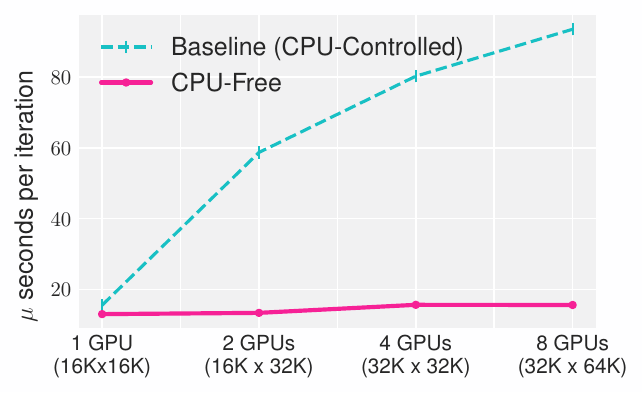This paper proposes a fully autonomous execution model for multi-GPU applications that completely excludes the involvement of the CPU beyond the initial kernel launch. In a typical multi-GPU application, the host serves as the orchestrator of the execution by directly launching kernels, issuing communication calls, and acting as a synchronizer for devices. We argue that this orchestration, or control flow path, causes undue overhead, and can be delegated completely to devices to improve performance in applications that require communication among peers. For the proposed CPU-free execution model, we leverage existing techniques such as persistent kernels, thread block specialization, device-side barriers and device-initiated communication routines to write fully autonomous multi-GPU code and achieve significantly reduced communication overheads. We demonstrate our proposed model on two broadly used iterative solvers, 2D/3D Jacobian stencil and Conjugate Gradient(CG). Compared to the CPU-controlled baselines, CPU-free model can improve 3D stencil communication overhead by 58.8% and provide 1.63x speedup for CG on 8 Nvidia A100 GPUs.
| Communication Overhead | Overlap Percentage |
|---|---|
 |
.png) |
- C++ Compiler with C++-17 support
- CUDA 11.6 or above
- NVSHMEM 2.7.0 or above
- GDRCopy 2.0 or above*
- InfiniBand GPUDirect Async support*
- OpenMPI 4.1.4 or above
*multi-node support
- Sample spack installation
$ spack install nvshmem +gpu_initiated_support +cuda +gdrcopy +ucx +mpi ^openmpi +cuda fabrics=ucx ^ucx +cuda +gdrcopy +dm +thread_multiple- Sample environment variables for Makefile
# spack load nvshmem
export NVSHMEM_HOME=$SPACK_HOME/.../nvshmem
export MPI_HOME=$SPACK_HOME/.../openmpi
export CUDA_HOME=$SPACK_ROOT/.../cuda
export UCX_HOME=$SPACK_ROOT/.../ucx
export LD_LIBRARY_PATH="$NVSHMEM_HOME/lib:$UCX_HOME/lib:$CUDA_HOME/lib:$MPI_HOME/lib:$LD_LIBRARY_PATH"We provide Direct P2P and NVSHMEM versions of Conjugate Gradient and 2D/3D Jacobian Stencil. Below are the provided targets:
make all: Compile all available versionsmake cg: Conjugate Gradient NVSHMEM implementationsmake stencil: Compiles all Stencil implementationsmake jacobi2D: Jacobi 2D Stencil P2P versionmake jacobi3D: Jacobi 3D Stencil P2P versionmake jacobi2D_nvshmem: Jacobi 2D Stencil NVSHMEM version*make jacobi3D_nvshmem: Jacobi 3D Stencil NVSHMEM version*
make format: Autoformat with.clang-format
Binaries are placed in bin/
Versions marked with * have multi-node support.
Each binary produced is a composite of multiple versions selected at runtime such as different CPU-Free implementations and Baselines. For example:
$ ./bin/cg
Versions (select with -v):
0: Baseline Discrete Standard
1: Baseline Discrete Pipelined
2: Single Stream Standard
3: Single Stream Pipelined
4: Single Stream Pipelined Multi Overlap
5: Single Stream Standard Saxpy Overlap
6: Profiling Discrete Standard
7: Profiling Discrete Pipelined
8: Single GPU Discrete Standard
Running Baseline Discrete Standard
Execution time: 24.8550 sSelect the desired version with the -v <version num> flag. CG versions additionally
support multiple versions delimited by ,, for example, ./bin/cg -v 0,1,2.
Baseline Copy/Overlap/P2P/NVSHMEM: Baseline versions taken from NVIDIA multi-gpu-programming-models.Design 1: CPU-Free P2P version with two streams.Design 2: CPU-Free P2P version with one stream.Design X NVSHMEM: (Available in NVSHMEM binaries) CPU-Free version with NVSHMEM communication.Design X Partitioned: CPU-Free version with better thread block partitioning.PERKS: Optimized caching implementations adapted from PERKS.
The best performing versions reported in the paper are Design 1 NVSHMEM and its Partitioned counterpart, and PERKS.
Discrete: ~Pipelined: ~Profiling: ~
-s: Suppress version information output. Prints execution time only.-v <version num>: Version selection. Default:0.-v <version num>[,version num...](CG only): Version selection-nx <dim>: X dimension size. Default:16384for 2D,512for 3D.-ny <dim>: Y dimension size.-nz <dim>: Z dimension size (if 3D).-niter <num>: Number of iterations. Default:1000.-compare: Accuracy comparison with 1 GPU.
Example:
$ ./bin/jacobi2D -s -v 3 -nx 1024 -ny 1024 -niter 10000Launching CG and Stencil NVSHMEM versions requires mpirun. Example:
$ mpirun -np 8 ./bin/jacobi3D_nvshmem -s -v 1 -nx 512 -ny 512 -nz 512 -niter 100No special parameters need to be set for multi-node launch.
@inproceedings{CPU-Free-Model,
author = {Ismayilov, Ismayil and Baydamirli, Javid and Sa\u{g}bili, Do\u{g}an and Wahib, Mohamed and Unat, Didem},
title = {Multi-GPU Communication Schemes for Iterative Solvers: When CPUs Are Not in Charge},
year = {2023},
url = {https://doi.org/10.1145/3577193.3593713},
doi = {10.1145/3577193.3593713},
booktitle = {Proceedings of the 37th International Conference on Supercomputing},
series = {ICS '23}
}This project has received funding from the European Research Council (ERC) under the European Union’s Horizon 2020 research and innovation programme (grant agreement No 949587).
- CPU-Free Stencil versions adapted from NVIDIA multi-gpu-programming-models repo.
- PERKS code adapted from neozhang307/PERKS.


